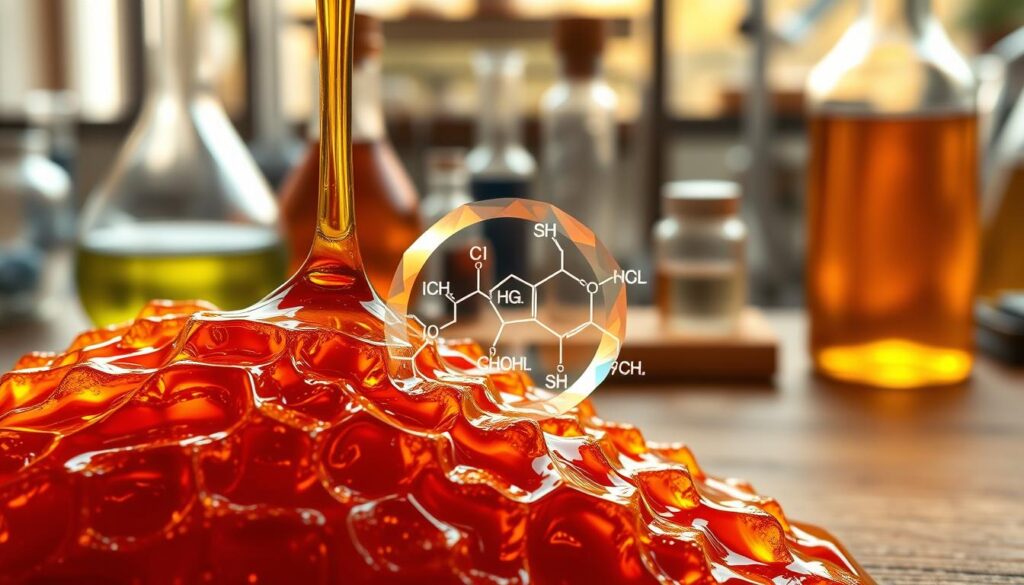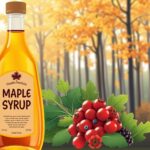Maple syrup is more than just a sweetener. It has a rich, complex makeup that turns tree sap into a nutritional gem. The ingredients in maple syrup are a mix of natural compounds, not just sugar. This makes it truly special.
In Vermont and Quebec, sugarmakers know maple syrup’s secrets. They see each drop as a complex mix of molecules. Scientists are studying this to learn more about its minerals, organic compounds, and unique elements.
Maple syrup is made from sap collected briefly from maple trees. It’s boiled down to concentrate the sugars and trace elements. This process creates its unique flavor and health benefits.
Tasting maple syrup is more than just sweetness. It’s a journey through nature’s chemistry and human skill. The ingredients in maple syrup tell a story of nature and human craftsmanship.
Researchers are finding out more about maple syrup’s makeup. They’re discovering its nutritional value and possible health benefits. Maple syrup is a blend of tradition and science, full of antioxidants and unique compounds.
Understanding Pure Maple Syrup: Nature’s Complex Sweetener
Maple syrup is a special liquid made from tree sap. It turns from sap into a golden liquid full of natural sweetness. This journey starts in North American forests, where maple trees store their treasure.
The process of making maple syrup is detailed and requires skill. Sugarmakers pick mature maple trees, like sugar maples, for their sap. This sap is full of flavor and nutrients.
From Tree to Table: Basic Processing Steps
Here’s how pure maple syrup is made:
- Tapping maple trees in late winter and early spring
- Collecting raw sap with special systems
- Boiling sap to make it sweeter and remove water
- Filtering to clean it up
- Grading by color and flavor
What Sets Pure Maple Syrup Apart
Pure maple syrup is different from other sugars. It keeps its natural chemicals. The analysis shows it has minerals, antioxidants, and trace elements that other sugars don’t have.
| Characteristic | Pure Maple Syrup | Refined Sugar |
|---|---|---|
| Mineral Content | High (Zinc, Manganese) | Minimal |
| Antioxidants | Abundant | None |
| Processing | Minimal, Natural | Extensive Refinement |
The nutritional content of maple syrup shows its natural roots. It’s a more complex and nutritious choice for those who care about their health.
Maple Syrup Chemical Composition: A Detailed Analysis
Maple syrup is more than just sugar. It’s a mix of natural compounds that make it complex. This sweet liquid has a unique nutritional profile thanks to its ingredients.
The ingredients in maple syrup create a complex chemical mix. This mix includes:
- Sugars (primary energy source)
- Minerals and trace elements
- Organic compounds
- Phenolic substances
- Amino acids
Sugarmakers know maple syrup is more than sweet. Each drop has a unique mix of molecules that add to its flavor and health benefits.
Studies show maple syrup has over 100 bioactive compounds. These range from simple sugars to complex molecules. This makes maple syrup stand out from other sweeteners.
The chemical makeup of maple syrup includes:
- Approximately 66% sucrose
- Small percentages of glucose and fructose
- Numerous trace minerals like zinc and manganese
- Antioxidant polyphenols
Knowing about these compounds shows maple syrup’s value. It’s not just sweet. It’s a complex natural product with great nutritional value.
The Sweet Science: Primary Sugar Components
Maple syrup’s sweetness comes from its special sugar mix. This mix makes its flavor stand out from other sweeteners.
The nutritional content of maple syrup shows a detailed sugar breakdown. This breakdown explains its unique taste and qualities.
Sucrose: The Dominant Sugar
Sucrose is the main sugar in maple syrup, making up 60-65% of it. This sugar gives maple syrup its famous sweetness.
Other Natural Sugars Present
- Glucose: Helps keep the syrup liquid
- Fructose: Adds a fruity sweetness
- Oligosaccharides: Bring out complex flavors
Glucose and Fructose Ratios
The mix of glucose and fructose makes maple syrup’s flavor special. Here’s how they balance:
| Sugar Type | Percentage | Flavor Contribution |
|---|---|---|
| Glucose | 20-25% | Smooth, mild sweetness |
| Fructose | 10-15% | Subtle fruity undertones |
“The sugar composition of maple syrup is nature’s own sweet symphony.” – Sugarmaker’s Wisdom
Together, these sugars make maple syrup’s rich, complex flavor. It’s what makes it a special natural sweetener.
Essential Minerals and Trace Elements
Maple syrup is more than just a sweetener. It’s packed with minerals that make it a healthier choice than refined sugar. Many see it as just a tasty topping, but it’s actually a treasure trove of nutrients.
Maple syrup is rich in minerals that are good for our health. Let’s look at the main minerals it offers:
- Calcium: Supports bone health and muscle function
- Potassium: Regulates heart and muscle performance
- Magnesium: Crucial for energy production and nerve function
- Zinc: Boosts immune system and supports healing
- Manganese: Aids in metabolism and bone formation
Pure maple syrup has more minerals than many other sweeteners. Just one tablespoon gives you a good amount of these nutrients. It’s a better choice for those looking for natural sweeteners.
Sugarmakers carefully get these minerals when they collect and boil the maple sap. The amount of minerals can change based on the tree’s location, soil, and how it’s harvested. Darker syrups have even more minerals, making them a more nutritious option.
Nature’s sweetener isn’t just about taste—it’s a complex blend of minerals that provide genuine nutritional benefits.
Organic Compounds That Define Maple’s Unique Profile
Maple syrup is more than just sweet. It has a mix of organic compounds that make it special. These compounds add to its flavor, color, and health benefits.
The makeup of maple syrup is complex and interesting. Scientists have found many organic compounds that make it unique.
Phenolic Compounds: Flavor’s Hidden Architects
Phenolic compounds are key to maple syrup’s taste. They help create:
- Rich, complex flavors
- Antioxidant properties
- Unique colors
Vanillin and syringaldehyde are important phenolic compounds. They give maple syrup its warm, inviting smell.
Bioactive Molecules: Nature’s Nutritional Powerhouse
Maple syrup has bioactive molecules that are good for health. These molecules work with our bodies in interesting ways. This makes maple syrup more than just a sweet treat.
“The organic compounds in maple syrup represent a complex chemical symphony that goes far beyond simple sugar.” – Food Chemistry Research Institute
Learning about these compounds shows why maple syrup is special. It offers a unique taste and health benefits.
Flavor-Contributing Chemical Compounds
Maple syrup’s amazing flavor comes from a mix of chemical compounds. These compounds form during the syrup-making process. They make the syrup taste rich and complex, not just sweet.
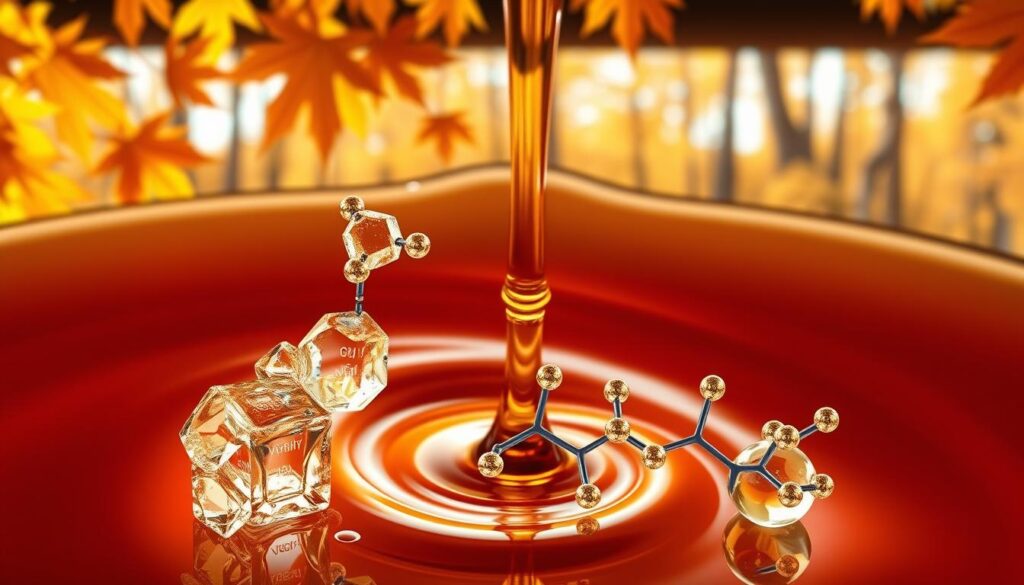
Sugarmakers know that the ingredients in maple syrup are key to its taste. Several important chemical groups help make the syrup’s flavor unique:
- Furans: Responsible for caramel-like notes
- Pyrazines: Deliver nutty and roasted characteristics
- Carbonyl compounds: Create complex aromatic elements
These compounds are made through complex chemical reactions when maple sap turns into syrup. The Maillard reaction is very important. It creates many flavor molecules when the sap is boiled.
| Compound Type | Flavor Characteristics | Formation Conditions |
|---|---|---|
| Furans | Caramel, sweet | High temperature processing |
| Pyrazines | Nutty, roasted | Extended heating |
| Phenolic Compounds | Woody, complex | Tree bark interaction |
Maple syrup grades vary in their flavor compounds. This affects their taste complexity and depth.
Antioxidant Properties and Their Sources
Maple syrup has a special kind of antioxidant that makes it different from other sweeteners. Unlike refined sugars, it has many protective compounds. These compounds could help improve your health.
Maple syrup’s unique mix of chemicals gives it strong antioxidant power. Scientists have found many beneficial molecules in it. These molecules help fight oxidative stress in our bodies.
Exploring Antioxidant Varieties
Maple syrup’s health benefits come from several antioxidant groups:
- Polyphenols: Powerful plant-based protective compounds
- Flavonoids: Natural molecules with strong cellular defense properties
- Phenolic acids: Additional protective chemical structures
Comparative Antioxidant Analysis
Maple syrup’s antioxidants are more impressive than other natural sweeteners. Studies show maple syrup has more antioxidants than honey, agave nectar, and refined sugar.
The amount of these compounds changes with the syrup’s color. Darker syrups have more antioxidants. This makes maple syrup not just tasty, but also good for you.
The Role of Amino Acids in Maple Syrup
Maple syrup is more than just sweet. It has a complex mix of amino acids that add to its nutritional value. These compounds are key to understanding what makes maple syrup special.
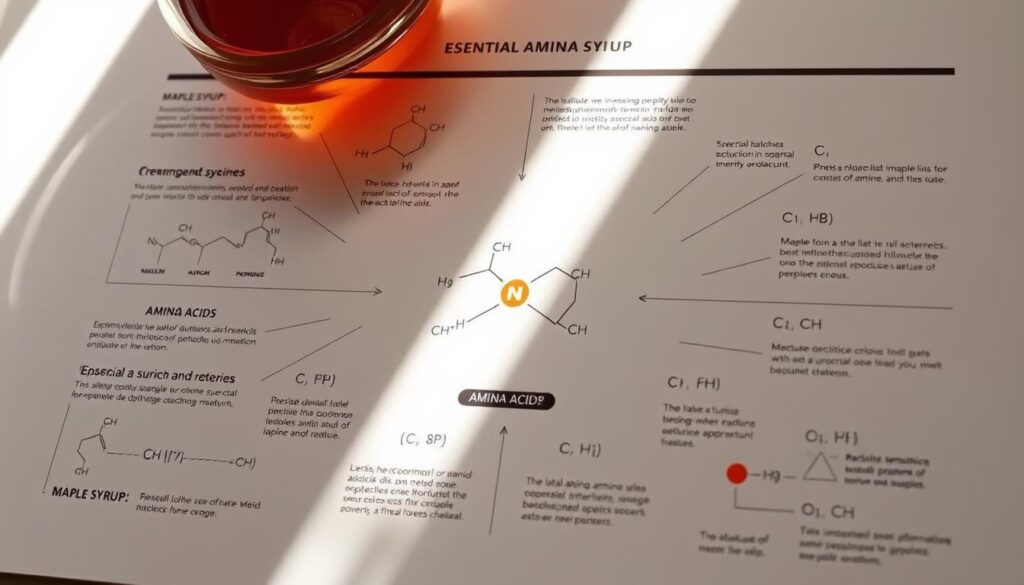
During production, sugarmakers find many amino acids in maple syrup. The syrup’s chemical makeup includes important amino acids. These come from the sap’s transformation during boiling.
- Aspartic acid
- Glutamic acid
- Threonine
- Serine
- Proline
Studies show that maple syrup has about 20 amino acids. These not only boost its nutritional value but also shape its unique taste.
| Amino Acid | Concentration (mg/100g) | Potential Benefit |
|---|---|---|
| Aspartic Acid | 45.6 | Supports metabolism |
| Glutamic Acid | 38.2 | Enhances immune function |
| Proline | 29.7 | Supports collagen production |
The amino acid profile makes maple syrup stand out from other natural sweeteners. It offers a unique nutritional benefit. These compounds form during the sap’s transformation into the golden syrup loved by many.
Maple syrup’s amino acids represent nature’s complex chemistry in action.
Color Classifications and Chemical Changes
Maple syrup’s color change is fascinating. It affects its flavor and quality. The USDA has four main color grades, each with its own chemical makeup.
The color system shows us what’s inside the syrup. As sap turns into syrup, its molecules change a lot:
- Golden Color (Delicate Taste): Lightest grade, produced early in the harvest season
- Amber Color (Rich Taste): Deeper color with more intense maple flavor compounds
- Dark Color (Robust Taste): Strongest flavor, harvested later in the season
- Very Dark Color (Strong Taste): Most concentrated maple syrup flavor
These colors come from chemical changes during syrup making. Maillard reactions happen when sap is boiled. This creates new flavors and darker colors. Sugarmakers watch these changes closely to keep the syrup special.
“The color of maple syrup tells a story of its journey from tree to table” – Traditional Sugarmaker’s Wisdom
As syrup gets darker, its flavors get stronger. Studies show that later syrups have more antioxidants and deeper flavors. Each grade offers a unique taste experience.
Health-Beneficial Compounds in Maple Syrup
Maple syrup is more than just a sweetener. It has a complex mix of compounds that could help your health. This golden liquid is full of interesting possibilities for those who care about wellness.
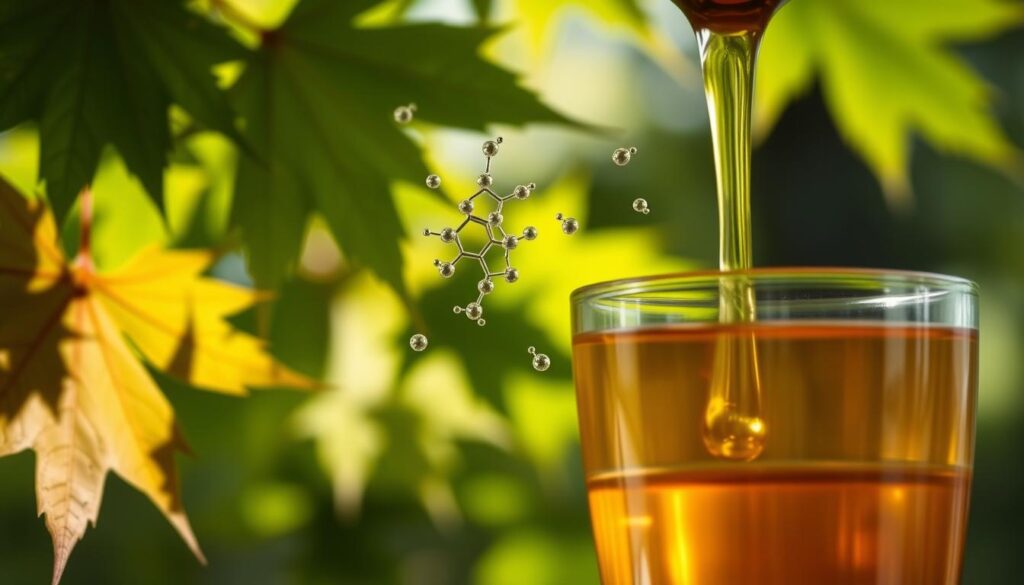
Scientists have found that maple syrup is packed with bioactive molecules. These molecules have health-protective qualities. Unlike regular sweeteners, maple syrup’s unique mix offers many benefits.
Anti-inflammatory Properties
Studies show maple syrup has compounds that fight inflammation. The phenolic compounds in it might help lower inflammation in cells. This is good news for those fighting chronic health issues.
- Polyphenols that support immune system function
- Antioxidant molecules that combat oxidative stress
- Natural compounds that may help reduce inflammatory responses
Potential Disease-Fighting Components
The organic compounds in maple syrup might help fight diseases. Early research is promising, but more studies are needed. These findings suggest maple syrup could have health-protective qualities.
| Compound | Potential Health Benefit | Research Status |
|---|---|---|
| Quebecol | Potential Anti-Cancer Properties | Preliminary Research |
| Polyphenols | Cellular Protection | Ongoing Studies |
| Manganese | Metabolic Support | Well-Established |
Experts say these findings are exciting, but maple syrup should be enjoyed in moderation. It’s best as part of a balanced diet.
Impact of Processing on Chemical Composition
Maple syrup analysis shows that how it’s made changes its chemical makeup. Turning raw sap into syrup involves many steps. These steps can change the syrup’s molecular structure.
Each method of making maple syrup creates a different chemical mix. Key factors include:
- Heat intensity during boiling
- Filtration techniques
- Storage conditions
- Duration of processing
Temperature is very important in changing maple syrup’s chemistry. High-temperature processing can damage some of the syrup’s compounds. This might lower its nutritional value and change its taste.
Filtration affects the syrup’s mineral and organic content. Fine filtration can remove sediment but might also lose some good molecules. Artisanal makers often choose less filtration to keep the syrup’s complex structure.
Storage conditions also cause chemical changes. Light, temperature changes, and the type of container can affect the syrup’s antioxidants and overall makeup. The right storage helps keep the syrup’s original chemical balance.
The art of maple syrup production lies in balancing traditional techniques with scientific understanding of its chemical complexity.
Today, maple syrup makers use advanced tests to track chemical changes. This ensures the syrup’s quality stays consistent and keeps its unique natural flavor.
Modern Analysis Methods for Maple Syrup Authentication
Maple syrup analysis has become more advanced. New scientific methods ensure its purity and quality. These tests are strict to protect consumers and keep standards high.
Today, scientists use top-notch technologies to check if maple syrup is real. They look for any fake ingredients. This is more than just tasting and looking at it.
- Isotope Ratio Mass Spectrometry (IRMS)
- Nuclear Magnetic Resonance (NMR) Spectroscopy
- Liquid Chromatography-Mass Spectrometry (LC-MS)
Isotope Ratio Mass Spectrometry is a key tool for checking maple syrup. It looks at the carbon and hydrogen in the syrup. This helps tell real maple syrup from fake ones.
“Precision in maple syrup analysis protects both producers and consumers,” says Dr. Emily Roberts, food science expert.
Nuclear Magnetic Resonance spectroscopy gives a detailed look at maple syrup’s chemistry. It can spot tiny changes in the syrup’s molecules. This means it can find even small amounts of fake ingredients.
| Analysis Method | Detection Capability | Accuracy Rate |
|---|---|---|
| Isotope Ratio Mass Spectrometry | Sugar composition | 99.5% |
| NMR Spectroscopy | Molecular structure | 99.8% |
| Liquid Chromatography | Chemical compounds | 99.2% |
These advanced methods keep maple syrup real and of high quality. They make sure we get a genuine, traditional sweetener.
Conclusion
Maple syrup is more than just sugar. It has a complex mix of compounds that give it a unique taste and health benefits. Its rich mineral profile and organic molecules show its complexity.
Scientists have found many valuable things in maple syrup. They’ve looked at its chemical makeup and found lots of nutrients. They’re also learning about its antioxidants, trace elements, and bioactive molecules.
More research is coming to help us understand maple syrup better. People are working together to learn more about its nutrition and health uses. This research is a mix of old traditions and new science.
As we learn more, maple syrup is seen as more than a sweetener. It’s a natural substance with lots of nutritional and medicinal possibilities. More research will keep showing us new ways maple syrup can benefit us.

